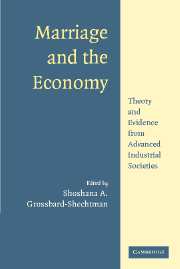Book contents
- Frontmatter
- Contents
- List of Figures
- List of Tables
- List of Contributors
- Foreword
- Acknowledgments
- Marriage and the Economy
- 1 Marriage and the Economy
- PART I THE ECONOMICS OF MARRIAGE AND DIVORCE
- 2 The Economics of Marriage and Household Formation
- 3 The Economics of Divorce
- 4 The Effects of Public Policy on Marital Status in the United States
- PART II EFFECTS OF MARRIAGE ON INCOME USES
- PART III EFFECTS OF MARRIAGE ON TIME USES
- PART IV MARRIAGE AND THE MACROECONOMY
- Index
3 - The Economics of Divorce
Published online by Cambridge University Press: 07 December 2009
- Frontmatter
- Contents
- List of Figures
- List of Tables
- List of Contributors
- Foreword
- Acknowledgments
- Marriage and the Economy
- 1 Marriage and the Economy
- PART I THE ECONOMICS OF MARRIAGE AND DIVORCE
- 2 The Economics of Marriage and Household Formation
- 3 The Economics of Divorce
- 4 The Effects of Public Policy on Marital Status in the United States
- PART II EFFECTS OF MARRIAGE ON INCOME USES
- PART III EFFECTS OF MARRIAGE ON TIME USES
- PART IV MARRIAGE AND THE MACROECONOMY
- Index
Summary
The far-reaching implications of the dissolution of a marriage for all family members are well known. The wife, who typically retains custody of the children, generally undergoes a significant decline in financial well-being following divorce(Saul D. Hoffman and Greg J. Duncan 1988). Growing up in a single-parent household deprives children of important inputs of parental time and money, and also limits their access to other family and community resources, with adverse effects both short term and long term (Sheila Krein and Andrea Beller 1988; Beller and John W. Graham 1993; Sara McLanahan and Gary Sandefur l994). It is thus important to understand how various factors influence the probability that a union will be dissolved. This chapter reviews the evidence on this issue, focusing primarily on determinants at the micro level. These include the characteristics of each of the spouses and the quality of their match, the behaviors of each partner during and before the marriage, and the role of new information and events that were unanticipated at the time of the marriage. I also discuss differences between first unions and remarriages.
This chapter first outlines the theory on the economic gains from marriage and the process of marital search, which is essential to understanding the determinants of divorce.Within this framework, I then discuss the empirical evidence on how various factors affect the risk that a union will eventually be dissolved. The emphasis is on microlevel factors, although I mention some macrolevel factors such as divorce laws at the end of this chapter (see also Chapter 4). The closing section highlights important areas where additional research is needed.
- Type
- Chapter
- Information
- Marriage and the EconomyTheory and Evidence from Advanced Industrial Societies, pp. 55 - 74Publisher: Cambridge University PressPrint publication year: 2003
- 18
- Cited by



